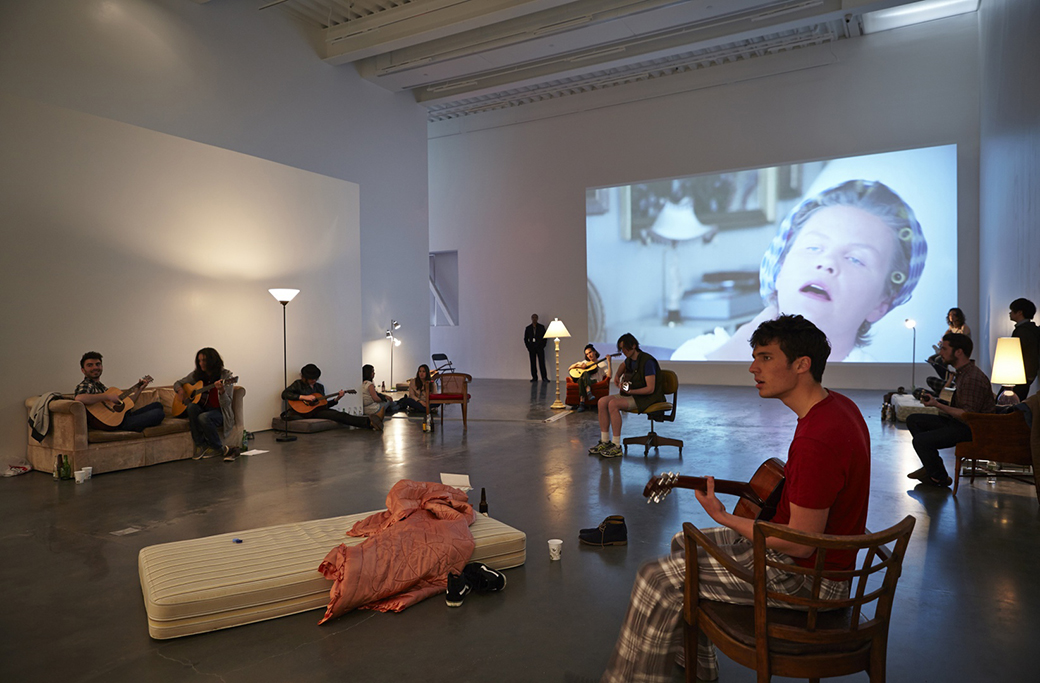
Ragnar Kjartansson. Me, My Mother, My Father, and I (exhibition view), 2014. Courtesy the New Museum.
Leaning against the wall, I listened as two musicians strummed beside me. What first sounded like loose improvisation evolved into a looping song with interwoven layers of melody, which rose and fell in gentle waves. The two played amongst a larger band of troubadours that were contained within one of the New Museum galleries; they were part of an ongoing performance and the heart of a recent show featuring the work of Icelandic artist Ragnar Kjartansson. After a few minutes, the musician beside me set down his guitar and walked to the nearby fridge for a short break and a cold beer. He then moved to a mattress lying in the center of the room, sprawled out on his back, and resumed playing, his hat falling backward to reveal the sweaty band of hair beneath.
A recurring theme in Kjartansson’s work is the use of durational performance to explore the persona of the performer. For this exhibition, Me, My Mother, My Father, and I, a rotating band of musicians played a ten-part polyphony (composed by Kjartan Sveinsson, former member of the Icelandic band Sigur Rós) that would continue all day, every day the gallery was open. In testing the limits of his performers, Kjartansson was also toying with our position as an audience. Exiting the elevator, I felt as though we were intruding on a private rehearsal; musicians sat in rolling chairs and on couches, a few flopped down on mattresses strewn about a space that seemed almost domestic. The viewers wandered amongst the musicians, taking photographs or videos of them at close range or sitting down beside them.
Collaborations between artists and musicians have long blurred the line between performance and sculpture. In the 1960s and ’70s, Korean artist Nam June Paik and American cellist Charlotte Moorman rose to prominence in the art world as an unlikely but dynamic duo working in mixed media. Inspired by the Fluxus movement and avant-garde scene in New York, their playful but radical performances integrated Paik’s experiments in video with Moorman’s dedication to “new music.” In 1967, Moorman achieved notoriety for her seminude performance of Paik’s Opera Sextronique, which resulted in her arrest on charges of indecent exposure; in another work, she was suspended by weather balloons outside the Sydney Opera House, playing her cello for two thousand spectators while floating over their heads. Moorman’s intentions were clear: “I am a sculpture and not a concert.”

Charlotte Moorman performs Sky Kiss (composition by Jim McWilliams), above the Sydney Opera House Forecourt in 1976 as part of the project Moorman + Paik. Courtesy Kaldor Public Art Projects.
Paik and Moorman rose with the early wave of performance art, embracing the intersection of technology, performance, and sound amidst contemporaries such as Joseph Beuys, Yoko Ono, John Cage, and Allan Kaprow. These times were revolutionary, especially for viewers confronted with what art and music were asking of them. The work’s completion relied on the participation of the spectator—this was a central tenet of the Fluxus movement. Was it a concert? A happening? Theater? For contemporary artists and musicians working together, such distinctions no longer feel necessary. We are a different audience. We readily absorb the layered approach, living in an environment of obsessive multimedia and multitasking.
When I left the New Museum that day, I wasn’t thinking about performance art. I understood the work as a musical performance within an art context, removed from the stage but still theatrical enough to maintain elements of the “fourth wall.” Could it be more, or did it even need to be? T Magazine recently published an interview with RoseLee Goldberg, founder of Performa, about the second life of performance (art): “Goldberg feels that live art has a new relevance to our culture, being well-matched to the anecdote-seeking Twitter generation, and offering the promise of intimate contact, an antidote to our atomized lives and fragmented concentration spans.” Goldberg’s definition of this new wave of “live art” poses questions about how the genre may be expanding, as well as the role of musicians within it.
This month, Luhring Augustine Bushwick will feature the video premiere of A Lot of Sorrow, another work by Kjartansson featuring the use of repetitive performance by musicians from The National, the Brooklyn-based indie rock band. In the video, filmed during a performance of the same name as part of MoMA PS1’s Sunday Sessions last year, The National plays the three-minute, twenty-five-second song “Sorrow” live onstage. Again and again. For six hours.
In the press release for the show, the artist’s works are described as being “connected through their pathos and humor, with each deeply influenced by the comedy and tragedy of classical theater. The artist’s use of durational, repetitive performance to harness collective emotion is a hallmark of his practice.” For the audience who attended the live marathon performance, I imagine it was something akin to what I felt with Kjartansson’s musicians: an experience that transcends the power of a single song, revealing itself as sculpture, a presence. The structure gets our attention but what holds us as an audience, I think, is an evolving sense of pathos in these works. Moving beyond emotions such as pity or compassion, Kjartansson invites us to submit to his confusion of knowing and not knowing at the same time. We do not know exactly how it will unfold or how to classify it, but we know that we are somehow in it together. In our fast, furious, and over-informed culture, perhaps this type of presence is the very respite we need.
Ragnar Kjartansson and The National’s A Lot of Sorrow is on view at Luhring Augustine Bushwick in Brooklyn, New York, through December 21, 2014.



